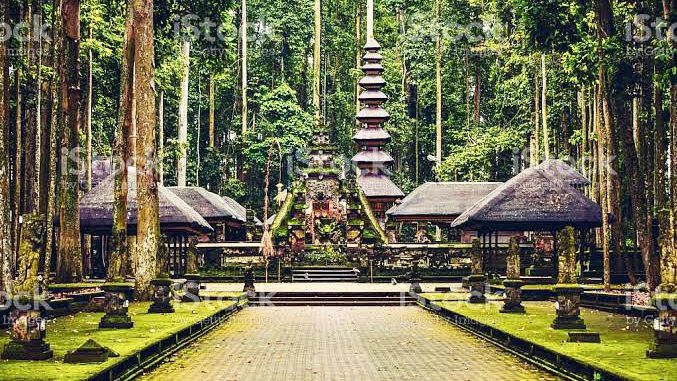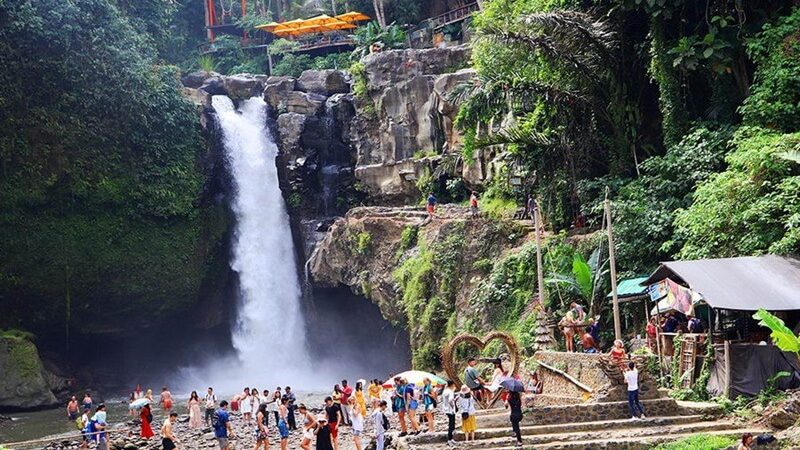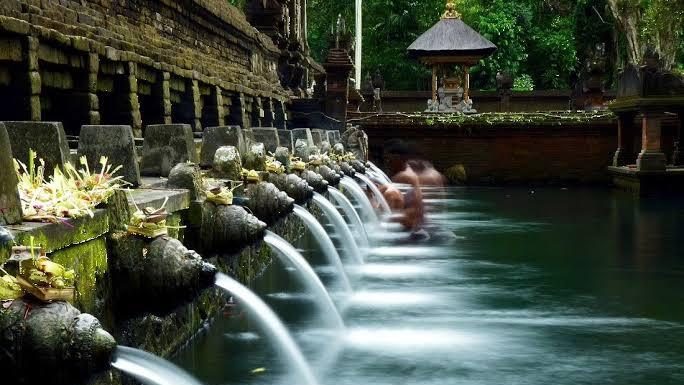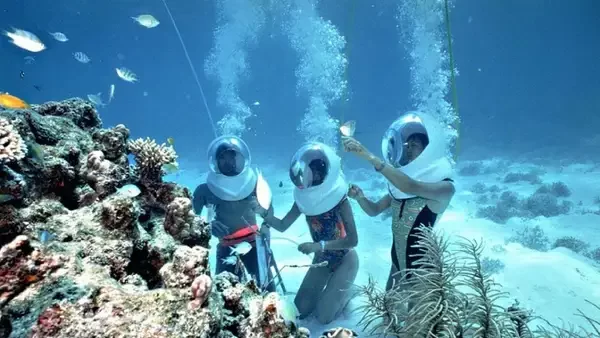Journey to Ubud
Prices
Order note Here Customer service fast respond Monday - Saturday, at 9 AM - 6 PM
If you want to order a special package, please contact us by telephone, click here!
Itinerary
Destination 1
Mandala Suci Wenara Wana, or well known as Ubud Monkey Forest, is the sanctuary and natural habitat of the Balinese long-tailed macaque. It is located at Padangtegal Ubud, Bali. About 1260 monkeys live in this sanctuary. They are divided into 10 groups, namely in front of main temple group, forest conservation group, central point group, eastern group, michelin group, ashram group, atap and cemeteries group. We also divide the monkeys by age: 63 adult male, 34 Sub-adult male, 219 Adult female, 29 Sub-adult female, 167 juveniles 1 (2-3 year), 118 juveniles 2 (1-2 year), 63 Infant old (5-12 month) and 56 infant. Sacred Monkey Forest Ubud is a famous tourist attraction in Ubud. In every month around 10,000–15,000 visitors come to Monkey Forest Ubud. The Monkey Forest Ubud has 186 species of plants and trees in 12,5 hectares of forest. The Monkey Forest Ubud has 3 temples, namely Dalem Agung Padangtegal Temple, Holy Spring Temple and Prajapati Temple. The forest is owned by the Padangtegal community and is managed by Mandala Suci Wenara Wana Management. The purpose of the management is to keep sacred the place and promote the Monkey Forest Ubud as an international tourist destination.
Destination 2
Tampaksiring is a town in central Bali, Gianyar Regency, Indonesia. As of the 2010 census, the area was 42.63 km2 and the population was 45,818; the latest official estimate (as at mid 2019) is 48,740. It is the home to the Gunung Kawi Temple and archaeological site and the Senang Hati Foundation.
The word "Tampak" in Balinese means foot, while "Siring" means Oblique. According to the legend the slope of the mountain where the town stands today, was created by footstep of a king named Mayadenawa. Tampaksiring was also one of the major kingdom during Bali's pre-colonial period. The town is home to Tirta Empul Temple
Tampaksiring is also location of Istana Tampaksiring, one of the 6 presidential palaces in Indonesia. The Palace was built between 1957 and 1960 at the initiation of President Sukarno. The buildings of the complex are scattered around on an area covering 19 hectares. The main palace building are built on a higher ground overlooking Tampaksiring Tirta Empul Temple and Mount Agung.
Destination 3
Kopi luwak is a coffee that consists of partially digested coffee cherries, which have been eaten and defecated by the Asian palm civet (Paradoxurus hermaphroditus). It is also called civet coffee. The cherries are fermented as they pass through a civet's intestines, and after being defecated with other fecal matter, they are collected. Asian palm civets are increasingly caught in the wild and traded for this purpose.
Kopi luwak is produced mainly on the Indonesian islands of Sumatra, Java, Bali, Sulawesi, and in East Timor. It is also widely gathered in the forest or produced in farms in the islands of the Philippines, where the product is called kape motit in the Cordillera region, kapé alamíd in Tagalog areas, kapé melô or kapé musang in Mindanao, and kahawa kubing in the Sulu Archipelago. Weasel coffee is a loose English translation of its Vietnamese name cà phê Chồn.
Producers of the coffee beans argue that the process may improve coffee through two mechanisms: selection – civets choosing to eat only certain cherries, and digestion – biological or chemical mechanisms in the animals' digestive tracts altering the composition of the coffee cherries.
The traditional method of collecting feces from wild Asian palm civets has given way to an intensive farming method, in which the palm civets are kept in battery cages and are force-fed the cherries. This method of production has raised ethical concerns about the treatment of civets and the conditions they are made to live in, which include isolation, poor diet, small cages, and a high mortality rate.
Although kopi luwak is a form of processing rather than a variety of coffee, it has been called one of the most expensive coffees in the world, with retail prices reaching US$100 per kilogram for farmed beans and US$1,300 per kilogram for wild-collected beans.
The origin of kopi luwak is closely connected to the history of coffee production in Indonesia; Dutch colonialists established coffee plantations in Indonesia and imported beans from Yemen. In the 19th century, farmers in central Java started to brew and drink coffee from excreted beans collected at their plantations.
Kopi luwak is brewed from coffee beans that transversed the gastrointestinal tract of an Asian palm civet, and were thus subjected to a combination of acidic, enzymatic, and fermentation treatment. During digestion, digestive enzymes and gastric juices permeate through the endocarp of coffee cherries and break down storage proteins, yielding shorter peptides. This alters the composition of amino acids and impacts the aroma of the coffee. In the roasting process, the proteins undergo a non-enzymatic Maillard reaction. The palm civet is thought to select the most ripe and flawless coffee cherries. This selection influences the flavour of the coffee, as does the digestive process. The beans begin to germinate by malting, which reduces their bitterness. When performed in nature, or in the wild, these two mechanisms achieve the same goal as selective picking and the wet or washed process of coffee milling: 1) harvesting optimally ripe cherries and 2) mechanically and chemically removing the pulp and skin from the cherry, leaving mainly the seed.
Traditionally, excreted coffee beans were collected directly in plantations and forests. As the international demand for kopi luwak increased, some producers turned to caged production methods to increase yields. In 2014, the annual kopi luwak production was grossly estimated at less than 127 kg. It is produced in Indonesia, East Timor, the Philippines, Thailand, Vietnam and Ethiopia.
The taste of kopi luwak varies with the type and origin of excreted beans, processing, roasting, aging, and brewing. The ability of the civet to select its berries, and other aspects of the civet's diet and health, like stress levels, may also influence the processing and hence taste.
Within the coffee industry, kopi luwak is widely regarded as a gimmick or novelty item. The Specialty Coffee Association of America (SCAA) states that there is a "general consensus within the industry...it just tastes bad". A coffee professional compared the same beans with and without the kopi luwak process using a rigorous coffee cupping evaluation. He concluded: "it was apparent that luwak coffee sold for the story, not superior quality...Using the SCAA cupping scale, the luwak scored two points below the lowest of the other three coffees. It would appear that the luwak processing diminishes good acidity and flavor and adds smoothness to the body, which is what many people seem to note as a positive to the coffee.” Professional coffee tasters were able to distinguish kopi luwak from other coffee samples, but remarked that it tasted "thin". Some critics claim more generally that kopi luwak is simply bad coffee, purchased for novelty rather than taste. A food writer reviewed kopi luwak available to American consumers and concluded "It tasted just like...Folgers. Stale. Lifeless. Petrified dinosaur droppings steeped in bathtub water. I couldn't finish it."
Several commercial processes attempt to replicate the digestive process of the civets without animal involvement. Researchers with the University of Florida have been issued with a patent for one such process. Brooklyn-based food startup Afineur has also developed a patented fermentation technology that reproduces some of the taste aspects of Kopi Luwak while improving coffee bean taste and nutritional profile.
Vietnamese companies sell an imitation kopi luwak, made using an enzyme soak which they claim replicates the civet's digestive process.
Imitation has several motivations. The high price of kopi luwak drives the search for a way to produce kopi luwak in large quantities. Kopi luwak production involves a great deal of labour, whether farmed or wild-gathered. The small production quantity and the labor involved in production contribute to the coffee's high cost. Imitation may be a response to the decrease in the civet population.
Growing numbers of intensive civet "farms" have been established and are operated in Southeast Asia, confining tens of thousands of animals to live in battery cages and be force-fed. "The conditions are awful, much like battery chickens", said Chris Shepherd, deputy regional director of TRAFFIC in Southeast Asia. "The civets are taken from the wild and have to endure horrific conditions. They fight to stay together but they are separated and have to bear a very poor diet in very small cages. There is a high mortality rate and for some species of civet, there's a real conservation risk. It is spiraling out of control". The trade in palm civets for the production of kopi luwak may constitute a significant threat to wild populations.
In 2013, People for the Ethical Treatment of Animals (PETA) investigators found wild-caught civets on farms in Indonesia and the Philippines. They were deprived of exercise, proper diet, and space. Video footage from the investigation shows abnormal behaviours such as repeated pacing, circling, or biting the bars of their cages. The animals often lose their fur. A BBC investigation revealed similar conditions. Farmers using caged palm civets in north Sumatra confirmed that they supplied kopi luwak beans to exporters whose produce ends up in Europe and Asia. Tony Wild, the coffee executive responsible for bringing kopi luwak to the Western world, has stated he no longer supports using kopi luwak due to animal cruelty and launched a campaign called "Cut the Crap" to halt the use of kopi luwak.
Kopi luwak is one of the most expensive coffees in the world, selling for between $220 and $1,100 per kilogram ($100 and $500/lb) in 2010. The price paid to collectors in the Philippines is closer to US$20 per kilogram. The specialty Vietnamese weasel coffee, which is made by collecting coffee beans eaten by wild civets, is sold at US$500 per kilogram. Most customers are Asian, especially those originating from Japan, China, and South Korea.
Some specialty coffee shops sell cups of brewed kopi luwak for US$35–80.
Investigations by PETA and the BBC found fraud to be rife in the kopi luwak industry, with producers willing to label coffee from caged civets with a "wild sourced" or similar label.
Genuine kopi luwak from wild civets is difficult to purchase in Indonesia and proving it is not fake is very difficult – there is little enforcement regarding use of the name "kopi luwak", and there's even a local cheap coffee brand named "Luwak", which costs under US$3 per kilogram but is occasionally sold online under the guise of real kopi luwak.
There are reports of a kopi luwak type process occurring naturally with muntjac and birds. Bat coffee is another variation that is in demand. Bats feed on the ripest coffee and fruits and spit out the seeds. These seeds are dried and processed to make coffee with a slight fruity flavor.
Destination 4
Ubud is most well-known by international travelers as the greenest part of Bali because it has a lot of tourist attractions with green features, such as lush forests, ridge walks, and rice terraces. One of the most popular green attractions here is Tegallalang Rice Fields. Also known as Tegallalang Rice Terrace, it is a series of beautifully arranged paddies which follows the traditional Balinese irrigation system called “subak.” The system is said to have been passed down by a sage named Rsi Markandeya in the 8th century.
THE SCENIC GREENERY
Tegallalang Rice Fields is situated in a valley that offers extraordinarily scenic lookouts over the terraces and surrounding green landscape. Along with the ones in the villages of Pejeng and Campuhan, Tegallalang Rice Fields form the three most stunning-looking terraced landscapes in Ubud region.
Since it has been listed in UNESCO World Heritage site, this place has gained popularity among international travelers. Nevertheless, it is still a great place to wind down and ease your mind as it offers a quiet and relaxing atmosphere.
Tegalalang Rice Terrace is only a short 20-minute drive north of Ubud, but those who prefer walking can take a two-hour on foot journey there. It’s relatively easy to reach, especially if you decide to take your own rented car or motorcycle. You can go there by taxi as well. There are many ways for you to choose, and every one of them offers different experiences that are equally convenient.
Once you arrive at Tegalalang Rice Fields, the first thing you can obviously do is to savor the view from the top of the elevation. However, it’s also possible for you to cross a small stream and get to the rice fields on the other side. We would suggest you climb down and explore the area further to find cool spots for you to take pictures. You will need approximately 30 minutes to 1.5 hours to explore every corner of the area. It’s not that lengthy, considering what you’ll find along the exploration will make it worthwhile. Don’t forget to bring water and put on some sunscreen!
Tegallalang Rice Fields offers a different kind of enjoyment that will make you want to visit Bali again and again. When you finally get here, don’t forget to always be a responsible traveler by always complying with the health protocols, which means to always practice healthy habits of social distancing, frequently washing hands, and putting on a mask in public places. Last but not least, always respect the locals and their beliefs.
Destination 5
Tegenungan Waterfall is a waterfall in Bali, Indonesia. It is located at the village of Tegenungan Kemenuh, also known as Kemenuh Village on the Petanu River in the Gianyar Regency, north from the capital Denpasar and close to the Balinese artist village of Ubud. The waterfall is isolated but has become a popular tourist attraction. It is one of the few waterfalls in Bali that is not situated in highlands or mountainous territory. The amount and clarity of the water at the site depend on rainfall but it contains green surroundings with fresh water that can be swum in. The waterfall includes varying highs that can be climbed after the descent down stairs to reach it. This attraction also features a viewing point to the jungle and waterfall at the main entrance.
Include(s)
- Fresh Water
- English speaking guide
- Car, driver, gasoline & parking
Exclude(s)
- Entrance Ticket
- Food & Snack
- Travel insurance
Note(s)
Ubud is a town on the Indonesian island of Bali in Ubud District, located amongst rice paddies and steep ravines in the central foothills of the Gianyar regency. Promoted as an arts and culture centre, it has developed a large tourism industry. It forms a northern part of the Greater Denpasar metropolitan area (known as Sarbagita).
Ubud, often mistaken for a small city, is an administrative district (kecamatan) with a population of 74,800 (as of the 2020 Census) in an area of 42.38 km2. The central area of Ubud desa (village) has a population of 11,971 and an area of 6.76 km2, and receives more than three million foreign tourists each year. The area surrounding the town is made up of small farms, rice paddies, agroforestry plantations, and tourist accommodations. As of 2018, more tourists visited Ubud than Denpasar in south.
Eighth-century legend tells of a Javanese priest, Rsi Markendya, who meditated at the confluence of two rivers (an auspicious site for Hindus) at the Ubud locality of Campuhan. Here he founded the Gunung Lebah Temple on the valley floor, the site of which remains a pilgrim destination.
The town was originally important as a source of medicinal herbs and plants; Ubud gets its name from the Balinese word ubad (medicine).
In the late 19th century, Ubud became the seat of feudal lords who owed their allegiance to the king of Gianyar, at one time the most powerful of Bali’s southern states. The lords were members of the Balinese Kshatriya caste of Suk, and were significant supporters of the village’s increasingly renowned arts scene.
Antonio Blanco, a Spanish-American artist, lived in Ubud from 1952 until his death in 1999. A new burst of creative energy came in the 1960s after the arrival of Dutch painter Arie Smit and the development of the Young Artists Movement. The Bali tourist boom since the late 1960s has seen much development in the town.
In 2002, terrorist bombings caused a decline in tourism throughout Bali including Ubud. In response to this a writer’s festival was created, Ubud Writers and Readers Festival to help revive tourism, the island’s main economic lifeline.
The main street is Jalan Raya Ubud (Jalan Raya means main road), which runs east–west through the center of town. Two long roads, Jalan Monkey Forest and Jalan Hanoman, extend south from Jalan Raya Ubud.
Puri Saren Agung is a large palace located at the intersection of Monkey Forest and Raya Ubud roads. The residence of Tjokorda Gede Agung Sukawati (1910–1978), the last ruling monarch of Ubud, it is still owned by the royal family. Dance performances and ceremonies are held in its courtyard. The palace was also one of Ubud’s first hotels, opening its doors back in the 1930s.
A number of Hindu temples exist, such as Pura Desa Ubud, which is the main temple, Pura Taman Saraswati, and Pura Dalem Agung Padangtegal, the temple of death. The Gunung Kawi temple is the site of the royal tombs. Goa Gajah, also known as the Elephant Cave, is located in a steep valley just outside Ubud near the town of Bedulu.
The Moon of Pejeng, in nearby Pejeng, is the largest single-cast bronze kettle drum in the world, dating from circa 300BC. It is a popular destination for tourists interested in local culture.
The economy of Ubud is highly reliant on tourism which focuses on shopping, resorts, museums, yoga, and zoos. There is a strong focus on sustainable economy in regard to the retail industry in Ubud, with many Bali-grown brands favoring materials and ingredients that would not cause much waste to the environment. From home and living amenities to tropical clothing brands, Ubud has quite a unique array of retail selections that have proven attractive to tourists from around the world.
One of the initiatives that have boosted Ubud as another popular tourist destination in recent years is Ubud Food Festival (UFF). Happening in less than a week in every April, this festival brings fellow restaurateurs and restaurants in Ubud together to create either special menus or particular promotions that may not be available in other months.
In contrast to the tourist area in southern Bali, the Ubud area is less densely populated by locals. However, tourists far outnumber locals, with the Gianyar regency seeing 3,842,663 tourist arrivals in 2017 – 1.3 million alone visiting Ubud Monkey Forest.
The town and area has a number of art museums, such as the Blanco Renaissance Museum, the Puri Lukisan Museum, Neka Art Museum, and the Agung Rai Museum of Art. The Museum Rudana in Peliatan is nearby. Galleries promoting local and overseas crafts are abound, too, in Ubud. Some often hold exhibitions focused on stimulating a dialogue between both local and international artists, and less about selling artworks. One of the primary examples is BIASA ArtSpace, founded by art enthusiast and fashion designer Susanna Perini.
The Tek Tok is a traditional Balinese dance that is accompanied by musical sound of mouth ‘Tek Tok’ altogether with various combinations of body movement and other sounds. The story Draupadi Parwa told in the Tek Tok Dance tells a moral message, when a woman who embodies the values of patience, sacrifice, compassion, devotion, and holy sincerity is disrespected, then disasters and calamities will befall a kingdom or state. This story also conveys the message that truth, virtue, devotion and genuine compassion will always be protected by God. The Tek Tok dance performance is held regularly at the Bali Culture Center (BCC) in Ubud four times a week. Ubud Writers and Readers Festival (UWRF) is held every year, which is participated by writers and readers from all over the world.
Many Balinese dances are performed around Ubud including the Legong by the Peliatan Dance Group, the first troupe to travel abroad.
Ubud kecamatan/district is made of up the following desa (villages): Kedewatan, Sayan, Singakerta, Peliatan, Mas, Lodtunduh, Petulu, and Ubud itself.
The Mandala Suci Wenara Wana is known to westerners as the Ubud Monkey Forest. The grounds contain an active temple and are located near the southern end of Monkey Forest Street. This protected area houses the Pura Dalem Agung Padangtegal, and as of June 2017, approximately 750 crab-eating macaque (Macaca fascicularis) monkeys live there.
The Campuhan ridge walk is a hill in nearby Campuhan, from where one can see two rivers, Tukad Yeh Wos Kiwa and Tukad Yeh Wos Tengen, merge. A one meter wide paved-block track runs about two kilometers to the top of the hill which is a popular spot to watch the sunset.
Order note Here Customer service fast respond Monday - Saturday, at 9 AM - 6 PM
If you want to order a special package, please contact us by telephone, click here!









